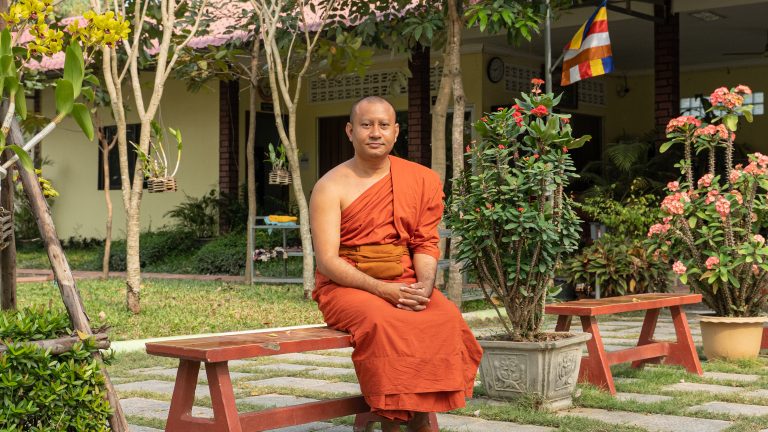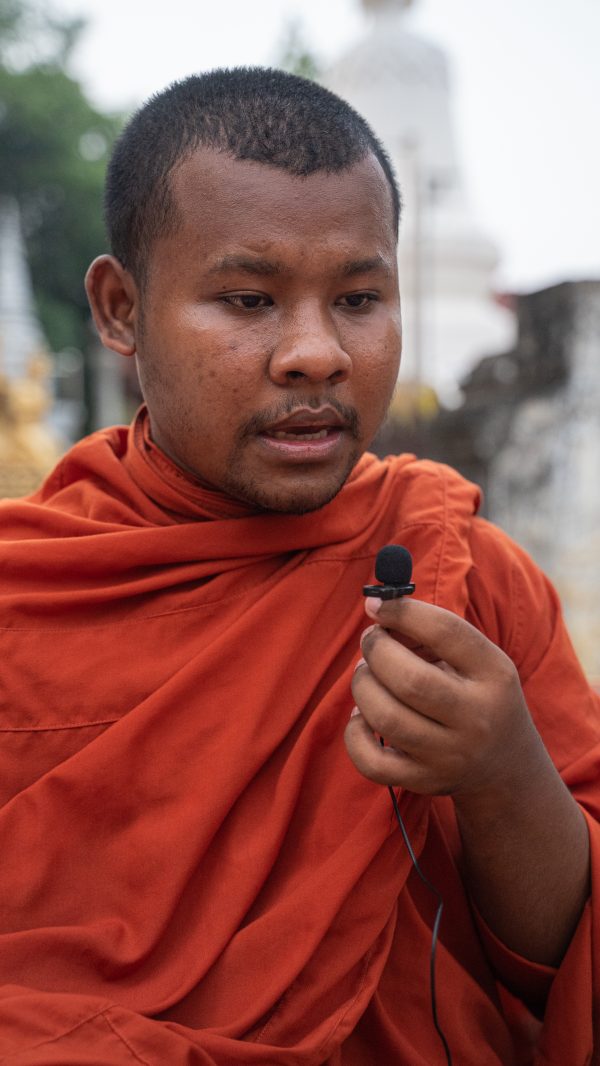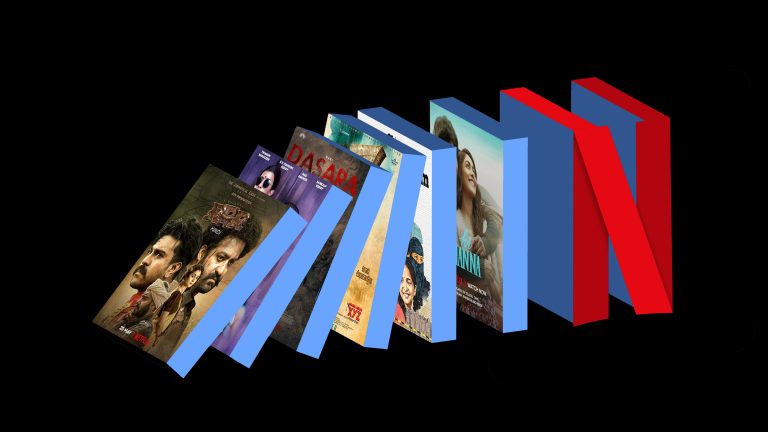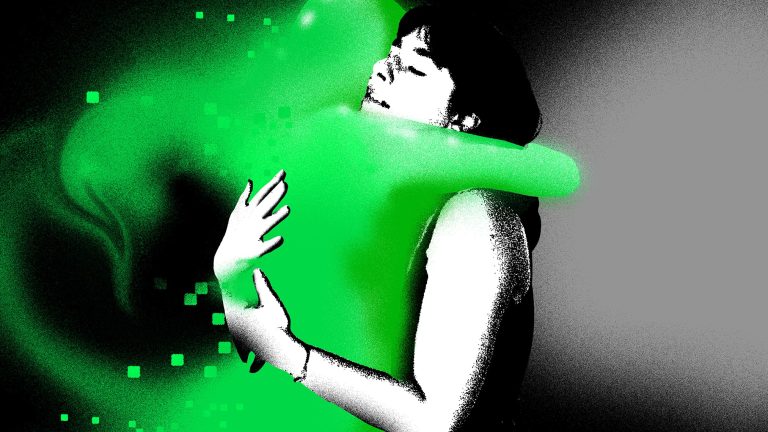Bo Pisey has a nightly ritual. After finishing his schoolwork and prayers, the 22-year-old Cambodian monk disappears into his room with his Android phone, locks the door, and sits on his bed. There, for hours, he edits TikTok videos for his 132,000 followers to watch before they fall asleep.
The other 29 people in his monastery are busy studying or chanting while Pisey records voice-overs, watches editing tutorials, and cuts footage. They still tease him about his hobby — even after his viewership exploded following two poetry videos he’d posted in the depths of the Covid-19 lockdowns.
“They’re like, ‘What is the benefit of doing this? Why are you spending hours on this?’” Pisey told Rest of World from his monastery in the northwestern city of Battambang. “I just want to spread the dharma. I don’t get anything from this, but I love doing it.”
TikTok has grown to become a force in entertainment in Cambodia, where 6.7 million adults out of a population of 17 million were using the app as of early 2022, according to parent company ByteDance. A scroll through Cambodian TikTok brings up local celebrities showing off luxury clothes, teenagers dancing to the rapper VannDa’s latest songs, and skincare influencers peddling products.
But a group of superstar monks have also carved out a niche for themselves, transporting their calling to the platform in the last few years. On TikTok, the monks preach Buddhist principles and ideas, known as dharma. Pisey’s follower count is modest compared to some, who have amassed more than half a million followers.


The rise of MonkTok also poses a new hazard for the Buddhist religious community: Dancing, singing, and fame-seeking — practically requisite behavior for TikTok stardom — are violations of the monastic code. Breaking the most serious rules can be punishable by expulsion from the order. In embracing TikTok, monks must tread a fine line — entertaining followers without angering Buddhist authorities, and spreading the dharma without alienating viewers. At the same time, monk authorities wrestle with the question: To what degree should monks be online in the first place?
For years, monks have taken to YouTube and Facebook — the “internet” of Cambodia — to dole out advice, share clips from speeches, and even monitor elections and deforestation via livestream. Being connected hasn’t always acted in their favor; one high-profile monk who had made his name as an online human rights defender was forced to flee the country after a government-linked Facebook campaign against him. But TikTok represents a different challenge: a shift toward a younger audience with expectations of trend-based, quick-hit content.
While many monks, like Pisey, say they’re on the platform to spread the dharma, others believe using TikTok is wrong because it puts monks on display. Some young monks’ accounts are indistinguishable from the accounts of laypeople: They post close-up thirst traps, teenage antics, and even fistfuls of cash, showy by most standards.

“Everything is changing,” Hak Sienghai, a 38-year-old TikTok monk also based in Battambang, told Rest of World. “This is how we propagate [the dharma]. We don’t need to go anywhere — people just open their smartphones … It’s a different era and a different time, but the same intention.”
Sienghai, whose account has more than 500,000 followers, supports other monks using TikTok, but is cautious about what he shows of his world. When he first joined the app in 2020, he’d post Khmer language and literature lessons in front of a whiteboard. But, over time, Sienghai developed a style that combined didactic content with an easy smile and a sense of humor.
In one clip, he sits alongside the Cambodian comedian Chab Chean — an unlikely pairing — to discuss an old tale about a man who went to the Buddha with a question, and ended up answering it himself. In a more unguarded moment, he shows monks traveling by motorboat to a pagoda, water spraying past them as they look quietly out on the Tonlé Sap lake.
“This is how we propagate [the dharma]. We don’t need to go anywhere — people just open their smartphones.”
“I try to make my followers closer with me from [TikTok] interactions,” Sienghai said. “But not really too close.” He discusses what he posts with the members of his temple’s administrative board and other prominent monks, trying to set an example for novice monks who view the app as entirely separate from their monastic duties.
“They don’t know how to use it for impact,” he said. “I worry about that.”

Pisey, who joined the order in 2013 at the age of 12, is more relaxed about using his personality to teach the dharma. He downloaded TikTok soon after he started his bachelor’s degree and saw how several students were glued to the app during class. Although about 70% of the Cambodian population uses Facebook, “most of the videos are long — same as on YouTube. It’s hard to listen for that long,” said Pisey. He first experimented with TikTok by posting photos of himself, guessing the algorithm would favor a human face.
Then, in April 2021, in the midst of a Covid-19 lockdown in Phnom Penh that saw armed forces patrolling the streets and people going hungry, Pisey read a poem into the camera and posted it to the app. “Everyone was told to stay home to avoid the disease. Rich people can stay at home without worrying, but the poor cannot,” it began.

The video struck a nerve, with more than 400,000 views rolling in. Pisey was stunned. It was his first experience with going viral. “I was so, so, so surprised,” he said. “That feeling motivated me to keep going.”
Since then, Pisey has focused on posting short, simple clips with his face or an illustration, to a voice-over of a Buddhist tale or principle. He steers clear of other content he’s seen from teenage monks that verges on the blasphemous: shirtless photos, love songs, or gambling games. “It’s not good behavior to show on TikTok,” he said. “People are going to see them as bad monks. But if you’re making TikToks to spread the dharma, it’s a really good way to interact with people.”
Ordained Cambodian monks, who practice Theravada Buddhism, are beholden to different rules than laypeople. The monastic code, which has 227 laws, forbids things like sex, eating after noon, and beds that are too comfortable. Even novice monks have to follow a list of basic precepts that includes refraining from killing, stealing, lying, singing, and dancing.
It’s enforced by a multilayered bureaucracy under the national monk council. At least half of the rules are aimed at preventing monks from generating personal admiration from the public or seeking fame — actions antithetical to TikTok stardom — according to Yon Seng Yeath, acting vice rector at a Buddhist university in Phnom Penh.
Seng Yeath, 45, serves as a member of the regional monk authority, overseeing four of the country’s 25 provinces. His job involves coordinating with higher- and lower-level monk authorities when problems arise, adjudicating potential punishments based on the monastic code, or imparting remedial education. In the last few years, he told Rest of World, Buddhist authorities have faced the “craziness” of monks risking their dignity online, mostly on Facebook.
Sitting in his Phnom Penh office, Seng Yeath pointed across the room to a solid-rock statue of the Buddha mounted on the wall.
“This statue represents the enlightenment, the wisdom, being touched by the Buddha,” he said. “But it can be used to destroy my office, to kill human beings, or whatever. The question then becomes, is this the mistake of the statue or the person using the statue? TikTok is such, too.”
No major scandals have brewed on TikTok yet, Seng Yeath said, only minor infractions like singing or dancing that could require an apology to one’s temple. But managing online controversies that aren’t an outright violation of the monastic code is tricky too. He recalled a viral video in which a child monk swore while receiving his Covid-19 vaccine. “This is a small, baby monk saying it,” he said. The incident was widely viewed as funny and sweet. But if it had been an adult, Seng Yeath noted, the public would have been upset. “It becomes, ‘Oh, this monk is immoral, it’s very bad you’re a monk, you have to be patient, you have to be silent.’”
Some vocal monks are more stringent about the use of TikTok. San Pisith, a 31-year-old monk who is studying for his PhD in Estonia, recently wrote an op-ed warning monks against seeking attention on social media and calling on national leaders to provide more systematic guidance, like a social media code of conduct.
“The question then becomes, is this the mistake of the statue or the person using the statue? TikTok is such, too.”
Although he doesn’t believe monks should entirely banish themselves from social media, he would like to see them make “100% educational content,” Pisith told Rest of World. “I think that’s one of the most ideal ways to deal with social media.” When accounts actively seek to grow or engage with followers too much, they risk betraying principles such as mindfulness and detachment, he said.
“Your main purpose is to educate people, to teach the dharma to the public. But you have a fear, a worry that if you don’t post this kind of [trendy] stuff, you’re losing your followers,” Pisith added. “It’s not what you should be going about as a monk.”
As for the more casual monks on TikTok, Seng Yeath thinks they aren’t cause for serious concern — yet. But the trend is troubling. Accounts tend to be run by teens who may only join monasteries for brief periods, showing moments that Buddhist higher-ups deem too intimate or silly for their sometimes thousands of followers. “In front of the congregation, no one would appear half-naked. But on TikTok, there’s more people watching them than in the congregation,” Seng Yeath said. “Then they appear half-naked. That kind of video is not proper at all.”
“The monks must try to understand what is the difference between TikTok and the real world,” he said. “For me, it’s just the same world, but different windows.”

TikTok monks themselves agree the community should have more oversight, perhaps by barring novices from having accounts or providing more training. But the monastic community has to use social media to reach people, Sienghai said.
“Surely, if the monk wants to detach from the world, have liberation — in Buddhism, go to the final destination — we should detach from social media and go to the forest and live there,” Sienghai said. “But for me and most monks, there are some levels to that.”
“We’re on the way” to enlightenment, he said. “And on this way, what should we do?”









